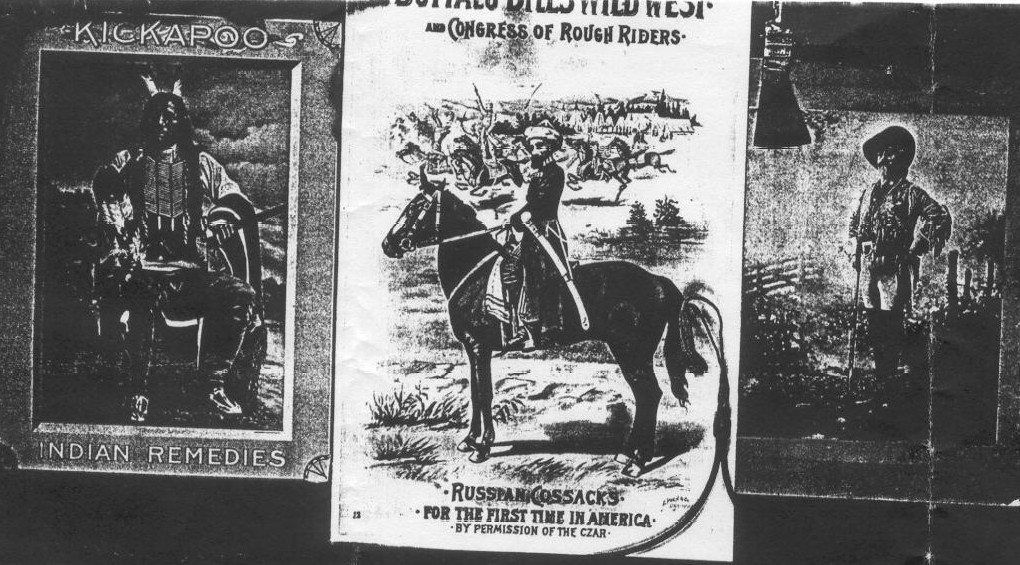
From left,
Kickapoo promotion by J. Ottmann Litho. Company, Puck Bldg., New York
City;
Chief Red Spear; 23½ x 17½ inches.(see
below)
Cossack riders by A. Hoen and Company; 30½ x 20'/,6 inches.
Unusually large Cody photograph by Stacy, Brooklyn, New York.
Redstone and carved-wood effigy pipe.
Reins of a horsehair bridle, late nineteenth century.
The tomahawk was a presentation to White Beaver.
Kickapoo Indian Medicine Company
The building was termed the principal wigwam,
and: the owners boasted a private museum in the building, replete with
displays of weaponry, curios, artifacts, and wild-animal trophies. Guests
were allowed a guarded look at these authentic treasures. All thief' served
to back up Kickapoo claims of the merit of their healing tonics.
Packages of Kickapoo Indian remedies had a
caution stamp, looking much like a cigar band, imprinted with Indian motifs
and the legend: CAUTION: NONE GENUINE WITHOUT THIS OUR SEAL & SIGNATURE
WHICH MUST BE ENTIRE AND UNBROKEN. In script was
the signature "Healy & Bigelow.'
A stream of publications was produced for
the faithful, with enticing titles such as The Indian Illustrated
Magazine and The Kickapoo Indian Dream Book. The reader was
encouraged to be temperate and to follow such homilies as:
I am Chief of the Kickapoo Indian tribe
And am strong as a brave can be,
Not brandy, nor whiskey do I imbibe,
Nor the Chinaman's poisonous tea.
But Indian Sagwa I often do take,
For it's good for man at least.
It cures the body of many an ache,
And stomach for many a feast.
The publications combined advice on health
and medical matters with entertainments, information, and promotions on
the Kickapoo product line.
One such publication, Kickapoo Indians: Life and Scenes Among the Indians,
ran feature articles, poetry, maps, and even biographies of Buffalo Bill
and the vanquished George Armstrong Custer. Texas Charlie became a heroic
figure in these articles and in dime novels. Brooks McNamara interprets
the phenomenon:
In their magazines, Healy and Bigelow were turning themselves into frontier heroes. The old raw West was rapidly dying out, replaced by a picturesque literary and theatrical West created by popular authors, showmen, and publicists. Healy and Bigelow, like Buffalo Bill Cody, were products of the nostalgia that accompanied the closing of the frontier; and like Cody their reputation as heroic Western figures was chiefly the result of a carefully conceived public relations campaign.
The main difference between Healy and Bigelow and Buffalo Bill was that the latter was a bona fide frontier hero. Healy and Bigelow developed their own medicine show with Indian performers whose job it was to help sell Kickapoo patent medicines. The Indians acted out scenes of terror, reflecting their reputation to city folk and the uninitiated, and at the same time performed domestic roles, the latter intended to help move the products. These encampments traveled about much like Cody's Wild West but were not on as grand a scale. Some whites also served the company, which claimed over eight hundred employees by the late 1880's. Alas, the actual Indians were never Kickapoos but primarily Eastern tribes like the Iroquois and tribes from the West like the Sioux, Blackfoot, and Cherokee. A few were hired from reservations, as was done by Cody, and some were enticed away from Buffalo Bill's Wild West.
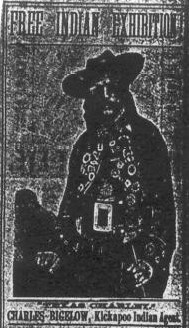
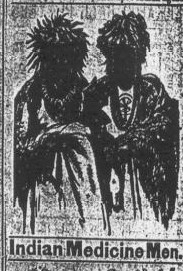
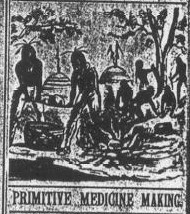
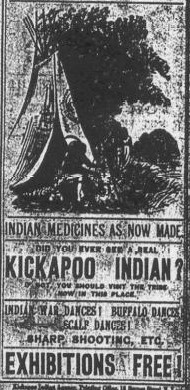
Flier promoting the Kickapoo encampments;
note reference to "Sharp Shooting" at right.
References:
Front-page obituary "Houston Chronicle" December 31, 1917 provided
by Dallas Public Library.
"Collecting the West" (pg. 128) by Wm. Ketchtun
"One for a Man, Two for a Horse" (pg.62) by a G. Carson - photocopy
provided by Wm. Ketchurn.
Miscl. Information provided by Connecticut Historical Society, letter
dated 9/8/98.
"Buffalo's Bill's Wild West" by Wilson & Martin, (pg. 230-234).
Color plates of Texas Charlie engraved rifle, advertising and SSA pistol
from (.9) Wilson & Somberland's book on Colt Firearms.
"Sixguns" by Elmer Keith (pg. 148).
''The American West Magazine" 2/1967, Vol 4, No.1) Long article
on Kickapoo Medicine, Healy & Bigelow and Texas Charlie.
Pictures and Information supplied by:
David T. Hulse
6992 S. CR 350 W
Clayton, IN 46118
Email: ThePines350@aol.com
go to kickapoo page 4. for pictures
and article on "Texas Charley" Rifle.
back to kickapoo page 2.
